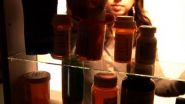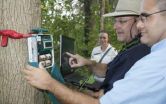(Press-News.org)
VIDEO:
Dr. Gary Smith, director of the Center for Injury Research and Policy at Nationwide Children's Hospital, explains that, over the past decade, drug-related poisonings have been on the rise in...
Click here for more information.
Over the past decade, drug-related poisonings have been on the rise in the United States. In fact, in many states drug-related poisoning deaths have now surpassed motor vehicle crash fatalities to become the leading cause of injury death. While the fatalities from this epidemic have been well reported, they are only the tip of the iceberg.
A new study by researchers at the Center for Injury Research and Policy of The Research Institute at Nationwide Children's Hospital examined emergency department (ED) visits for drug-related poisonings and found that in just one year (2007) in the U.S., there were approximately 700,000 ED visits costing nearly $1.4 billion in ED charges alone. This equates to an average of 1,900 drug-related ED visits and $3.8 million in ED charges each and every day in this country.
"The magnitude of these findings is staggering," said Gary Smith, MD, DrPH, senior author of the study and director of the Center for Injury Research and Policy at Nationwide Children's Hospital. "The number and cost of drug-related poisonings identified in this study indicate a public health emergency that requires a decisive and coordinated response at national, state and local levels."
According to the study, appearing in the March 2011 issue of the American Journal of Emergency Medicine, poisoning by antidepressants and tranquilizers (24 percent) and poisoning by pain and fever control medicines (23 percent) were responsible for almost half of ED visits for drug-related poisoning. Among cases involving antidepressants and tranquilizers, 52 percent were suicidal poisonings and 30 percent were unintentional poisonings. In comparison, 41 percent of poisonings by pain and fever control medicines were suicidal and 40 percent were unintentional.
"The current epidemic of drug-related poisonings has a new face," said Dr. Smith, also a Professor of Pediatrics at The Ohio State University College of Medicine. "Unlike epidemics in the past involving illegal drugs, such as heroin and crack cocaine, misuse of prescription drugs, especially opioid pain medications, is now the cause of an unprecedented number of emergency department visits and deaths. Our study also demonstrated that the rate of ED visits for drug-related poisoning is three times higher in rural areas than in non-rural areas."
Also of concern was the study's finding that children 5 years and younger had a higher rate of ED visits for unintentional drug-related poisonings than all other age groups.
"Despite the fact that successful prevention strategies targeted at young children have helped to decrease the occurrence of drug-related poisonings in this population, the number of unintentional poisonings among this age group is still too high," said Dr. Smith. "Our findings reinforce the importance of increasing efforts to prevent unintentional drug exposures among young children in the United States."
Data for this study were obtained from the 2007 Nationwide Emergency Department Sample (NEDS), one of the Health Care Utilization Project data sets from the Agency for Healthcare Research and Quality. NEDS data enable analyses of ED utilization patterns and yield national estimates of ED visits. The 2007 NEDS was released in April 2010. The data set includes approximately 27 million ED visits from about 970 hospital-based EDs in 27 states, and it generates national estimates pertaining to more than 120 million ED visits.
INFORMATION:
The Center for Injury Research and Policy (CIRP) of The Research Institute at Nationwide Children's Hospital works globally to reduce injury-related pediatric death and disabilities. With innovative research as its core, CIRP works to continually improve the scientific understanding of the epidemiology, biomechanics, prevention, acute treatment and rehabilitation of injuries. CIRP serves as a pioneer by translating cutting edge injury research into education, policy and advances in clinical care. For related injury prevention materials or to learn more about CIRP, visit http://www.injurycenter.org. While visiting our website, sign up for the RSS feed in the What's New section of our media center to receive updates of our latest news.
New study: Medical and financial impact of drug-related poisonings treated in US EDs
In just 1 year, there were 700,000 emergency visits for drug-related poisoning, costing the US nearly $1.4 billion
2011-03-02
ELSE PRESS RELEASES FROM THIS DATE:
Signaling path in brain may prevent that 'I'm full' message, UT Southwestern scientists discover
2011-03-02
DALLAS – March 1, 2011 – Researchers at UT Southwestern Medical Center have identified a signaling pathway in the brain that's sufficient to induce cellular leptin resistance, a problem that decreases the body's ability to "hear" that it is full and should stop eating.
"Leptin resistance is a significant factor, yet the mechanisms that underlie the problem remain unclear," said Dr. Joel Elmquist, professor of internal medicine and pharmacology at UT Southwestern and senior author of the study appearing in the March issue of Cell Metabolism. "The fact that this cellular ...
Policies to reduce medical residents' fatigue may compromise quality of training
2011-03-02
ROCHESTER, Minn. -- Recent Accreditation Council for Graduate Medical Education (ACGME) limits aimed to enhance patient safety may compromise the quality of doctors' training, according to a study by Mayo Clinic researchers published in the March issue of Mayo Clinic Proceedings (http://www.mayoclinicproceedings.com).
Patient safety has long been a critical concern for hospitals, in particular for those training new doctors. Since 1984, when the death of 24-year-old Libby Zion at a New York hospital was attributed to an overtired medical resident, training programs have ...
Building trust with cooperative witnesses in a crime investigation
2011-03-02
GREENSBURG, PA—March 1, 2011— Imagine that you witness a crime. The police investigator brings you to the police station to obtain an official statement, but between the crime and your official witness statement, you are exposed to other (potentially inaccurate) information about the crime. Before administering the criminal interview, the investigator asks you a litany of mundane demographic questions in a dry and uninterested manner, then moves directly into the interview about the crime. Would you feel comfortable? Most importantly, would your report be accurate and detailed, ...
Measuring methane
2011-03-02
MADISON, WI, MARCH 1, 2011 – Methane is an extremely potent greenhouse gas. Wetlands, gas hydrates, permafrost, termites, oceans, freshwater bodies, non-wetland soils, are all natural sources of atmospheric methane; however, the majority of methane presence ca n be accredited to human-related activities. These activities include: such as fossil fuel production, biomass burning, waste management and animal husbandry. The release of methane into the atmosphere by cattle and other large grazing mammals is estimated to account for 12 to 17% of the total global methane release.
Recently, ...
Scientists unravel the mysterious mechanics of spider silk
2011-03-02
Scientists now have a better understanding of why spider silk fibers are so incredibly strong. Recent research, published by Cell Press on February 15th in Biophysical Journal, describes the architecture of silk fibers from the atomic level up and reveals new information about the molecular structure that underlies the amazing mechanical characteristics of this fascinating natural material.
Spiders spin silk, which is remarkably strong and stretchy, to use in webs and to suspend themselves. "Silk fibers exhibit astonishing mechanical properties. They have an ultimate ...
New scientific field will study ecological importance of sounds
2011-03-02
WEST LAFAYETTE, Ind. - A Purdue University researcher is leading an effort to create a new scientific field that will use sound as a way to understand the ecological characteristics of a landscape and to reconnect people with the importance of natural sounds.
Soundscape ecology, as it's being called, will focus on what sounds can tell people about an area. Bryan Pijanowski, an associate professor of forestry and natural resources and lead author of a paper outlining the field in the journal BioScience, said natural sound could be used like a canary in a coal mine. Sound ...
Study: Happiness improves health and lengthens life
2011-03-02
CHAMPAIGN, lll. — A review of more than 160 studies of human and animal subjects has found "clear and compelling evidence" that – all else being equal – happy people tend to live longer and experience better health than their unhappy peers.
The study, in the journal Applied Psychology: Health and Well-Being, is the most comprehensive review so far of the evidence linking happiness to health outcomes. Its lead author, University of Illinois professor emeritus of psychology Ed Diener, who also is a senior scientist for the Gallup Organization, of Princeton, N.J., analyzed ...
For alcoholics, new help in abstaining -- without thinking about it
2011-03-02
Alcoholism is a tough addiction to kick. Eventually, most people return to drinking. But some Dutch and German psychological scientists have tested a short-term regime that promises to help alcoholics stay sober. Their study is published in Psychological Science, a journal of the Association of Psychological Science.
Heavy drinkers tend to behave impulsively in response to temptation. Meanwhile, their "reflective," or controlled, responses—the thoughts that would help them resist drinking—are often weak. Most therapies, including Cognitive Behavior Therapy, primarily ...
Researchers pinpoint patients who receive greatest benefit from heart failure treatment
2011-03-02
Mild heart failure patients with a particular condition that results in disorganized electrical activity throughout the heart benefit substantially from cardiac resynchronization therapy with defibrillator (CRT–D), according to a study published in the American Heart Association journal Circulation.
In patients with the condition, known as left bundle branch block or LBBB, CRT-D therapy reduced heart failure progression and the risk of ventricular tachyarrhythmias, fast and potentially life-threatening heart rhythms. Heart failure patients without LBBB did not receive ...
Scientists discover genetic switch that increases muscle blood supply
2011-03-02
Many people suffer from a devastating condition known as critical limb ischemia (CLI) that can lead to muscle wasting and even amputation. The disease is linked to the blockage of blood flow to the skeletal muscle and current treatment options include rehabilitative exercise and surgical bypass of blood vessels. New preclinical research suggests there may be a way to restore blood supply in skeletal muscle without traditional intervention.
Scientists at The University of Texas Health Science Center at Houston (UTHealth) and the Salk Institute for Biological Studies ...
LAST 30 PRESS RELEASES:
Making lighter work of calculating fluid and heat flow
Normalizing blood sugar can halve heart attack risk
Lowering blood sugar cuts heart attack risk in people with prediabetes
Study links genetic variants to risk of blinding eye disease in premature infants
Non-opioid ‘pain sponge’ therapy halts cartilage degeneration and relieves chronic pain
AI can pick up cultural values by mimicking how kids learn
China’s ecological redlines offer fast track to 30 x 30 global conservation goal
Invisible indoor threats: emerging household contaminants and their growing risks to human health
Adding antibody treatment to chemo boosts outcomes for children with rare cancer
Germline pathogenic variants among women without a history of breast cancer
Tanning beds triple melanoma risk, potentially causing broad DNA damage
Unique bond identified as key to viral infection speed
Indoor tanning makes youthful skin much older on a genetic level
Mouse model sheds new light on the causes and potential solutions to human GI problems linked to muscular dystrophy
The Journal of Nuclear Medicine ahead-of-print tip sheet: December 12, 2025
Smarter tools for peering into the microscopic world
Applications open for funding to conduct research in the Kinsey Institute archives
Global measure underestimates the severity of food insecurity
Child survivors of critical illness are missing out on timely follow up care
Risk-based vs annual breast cancer screening / the WISDOM randomized clinical trial
University of Toronto launches Electric Vehicle Innovation Ontario to accelerate advanced EV technologies and build Canada’s innovation advantage
Early relapse predicts poor outcomes in aggressive blood cancer
American College of Lifestyle Medicine applauds two CMS models aligned with lifestyle medicine practice and reimbursement
Clinical trial finds cannabis use not a barrier to quitting nicotine vaping
Supplemental nutrition assistance program policies and food insecurity
Switching immune cells to “night mode” could limit damage after a heart attack, study suggests
URI-based Global RIghts Project report spotlights continued troubling trends in worldwide inhumane treatment
Neutrophils are less aggressive at night, explaining why nighttime heart attacks cause less damage than daytime events
Menopausal hormone therapy may not pose breast cancer risk for women with BRCA mutations
Mobile health tool may improve quality of life for adolescent and young adult breast cancer survivors
[Press-News.org] New study: Medical and financial impact of drug-related poisonings treated in US EDsIn just 1 year, there were 700,000 emergency visits for drug-related poisoning, costing the US nearly $1.4 billion



